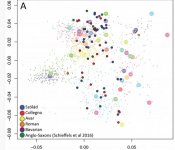Angela
Elite member
- Messages
- 21,823
- Reaction score
- 12,329
- Points
- 113
- Ethnic group
- Italian
This is from a poster of a recently presented paper by C. Eduardo Amorim
See:
https://www.dropbox.com/s/sgvuxv3h2p09aju/poster_hinxton.pdf?dl=0
This is another one where I'm going to need the actual paper to figure out what's going on.
Did they find that the Langobard samples from Hungary already included samples much like Finns and other far north and northeastern Europeans and also ones that were already very "Italian like". One of those Hungary samples lands practically on my head going by it's placement on the map of Italian variation.
Is the exact same thing true for the samples found in the Lombard sample in western Piemonte?
As to the former I suppose it makes sense as a sign that the Langobards mixed with still very EEF like populations in Iron Age Hungary.
However, if that's the case, then how can any estimates be made of how much impact the Langobards had on northern and Central Italian genetics?

Also, what do they mean about all these CEU samples in northern Italy. Didn't they use anything other than 1000 genomes? What they may be picking up is "Celtic" samples from the Celtic migrations into Northern Italy that first arrived around 400 BC.
Also, what place and time period does that lone "Roman" sample come from? It seems to place at the meeting point between Spanish and Northern Italian populations. "Roman" meant different things at different time periods. Is it a local sample from Piemonte from the same time as the Langobard settlement?
Any insights would be greatly appreciated.
Also, if you can get bigger and clearer pictures of the various graphics in the poster that would be great.
See:
https://www.dropbox.com/s/sgvuxv3h2p09aju/poster_hinxton.pdf?dl=0
This is another one where I'm going to need the actual paper to figure out what's going on.
Did they find that the Langobard samples from Hungary already included samples much like Finns and other far north and northeastern Europeans and also ones that were already very "Italian like". One of those Hungary samples lands practically on my head going by it's placement on the map of Italian variation.
Is the exact same thing true for the samples found in the Lombard sample in western Piemonte?
As to the former I suppose it makes sense as a sign that the Langobards mixed with still very EEF like populations in Iron Age Hungary.
However, if that's the case, then how can any estimates be made of how much impact the Langobards had on northern and Central Italian genetics?

Also, what do they mean about all these CEU samples in northern Italy. Didn't they use anything other than 1000 genomes? What they may be picking up is "Celtic" samples from the Celtic migrations into Northern Italy that first arrived around 400 BC.
Also, what place and time period does that lone "Roman" sample come from? It seems to place at the meeting point between Spanish and Northern Italian populations. "Roman" meant different things at different time periods. Is it a local sample from Piemonte from the same time as the Langobard settlement?
Any insights would be greatly appreciated.
Also, if you can get bigger and clearer pictures of the various graphics in the poster that would be great.

